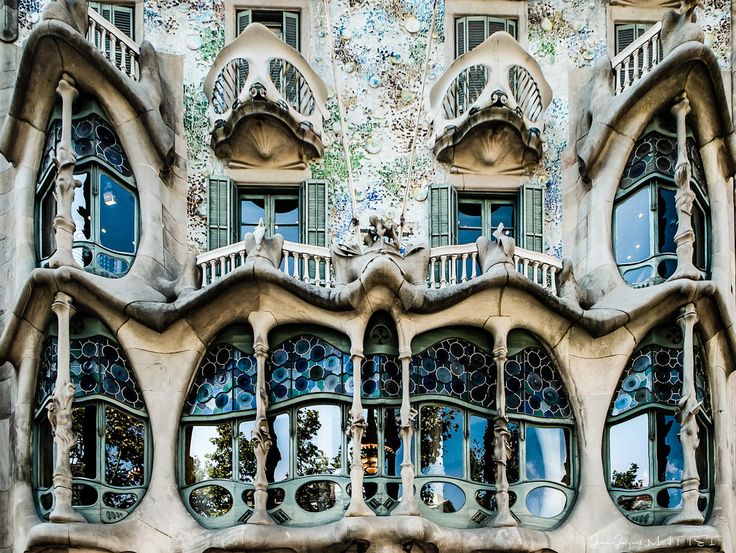AD Classics: AD Classics: Casa Batlló / Antoni Gaudí
AD Classics: AD Classics: Casa Batlló / Antoni Gaudí
via Wikipedia
- Written by Megan Sveiven
+ 10
-
Architects:
Antoni Gaudí - YearCompletion year of this architecture project
Year:1906
- Photographs
Photographs:Wikipedia, Ignasi de Solá-Morales, John Gill
- ManufacturersBrands with products used in this architecture project
Manufacturers: Parquets Nadal
Text description provided by the architects. The inspiring imagination of Antoni Gaudí undoubtedly reveals itself in one of his most poetic and artistic designs for a building, Casa Batlló. His synthesis of animal shapes, vine-like curves, hints of bone and skeleton, and his use of lustrous colored bits of glazed ceramic and glass create a masterpiece that will forever astonish its observers.
via Wikipedia
His style encompasses all that defines the Art Nouveau, a School of French decorative artists from the 1890s who took influence from sinuous shapes in plants and nature.
via Wikipedia
He explored his interests in flowing shapes, patterns and colors in the Casa Batlló, which was designed for the wealthy cotton baron Josep Batlló as a jolting contradiction to the rigid forms that surround it.
via Wikipedia
The front facade reveals striking textures, colors, and imagery that work together to conjure thoughts of fairytales and phantasmal dreams. The larger sculptural pieces that create the boundaries of the balconies and that frame the entrance resemble bones, suggesting a septum, eyebrows or clavicles, which keep to the anthropomorphic tone. As eyes wander up to the top of Casa Batlló, they are greeted by the dominating reptillian surface of the roof.
© Ignasi de Solá-Morales
The dramatic humpback mound “is clad on one side by armour plating resembling an armadillo’s, while on the other side it is covered with trancedis fragments producing a subtle white-into-orange sheen.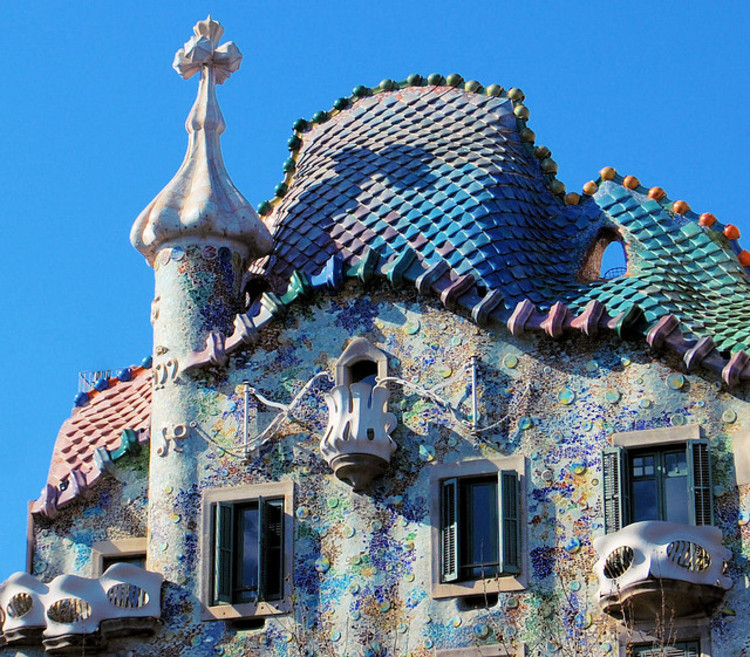
© John Gill
The spine is dotted with bulbous green and blue vertebrae, suggesting that these might be organisms in themselves, while the flowing lines where roof meets facade are edged with other armatures of saurian bone and joint.”
via Wikipedia
The creaturesque resemblance is made strikingly apparent at night, when the facade glows and haunts with it’s bone-like skeletal structures and dramatic shadows. Antoni Gaudí worked closely with a textile manufacturer named Josep Maria Jujol who assisted primarily in the ornamentation and use of color on the surface treatments.
via Wikipedia
As can always be anticipated in the works of Gaudí, there is a recurring religious imagery which is achieved almost subliminally. There are embedded and semi-concealed religious images and texts planted in the upper levels of the building, as well as in the small details around the facade.
via Wikipedia
The very tip of the tower sits one of Gaudí’s signature pieces, a four-pointed transverse cross.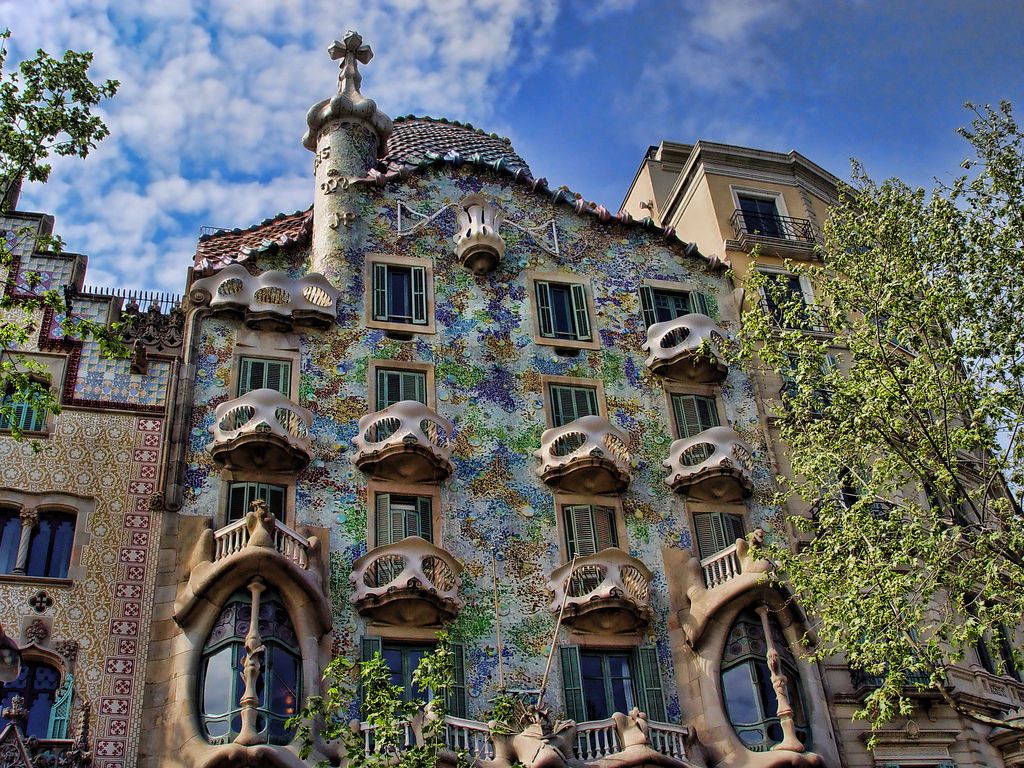
© Ignasi de Solá-Morales
Gaudí’s state of the art use of central heating, uncommon in the time and place of Barcelona, made air vents and chimneys necessary. He took this as yet another place to expand his talents and imaginations, adding to the fairytale structure and appearance of Casa Batlló. One of the most intriguing aspects of these chimneys are their 45-degree angle departure from the roof before they become vertical.
© Ignasi de Solá-Morales
As an artist and believer in an all-encompassing design, it is unsurprising that the intensity of detail and materiality is not left to the exterior alone.
© Ignasi de Solá-Morales
The interior is perhaps even more detailed and designed, a continuation of the sinuous flowing walls and edges as well as color manipulation and incredible varying of the scale.
© Ignasi de Solá-Morales
The interior is just as alive as it appears from the street; the knobbly spine lines the staircase through flowing wall forms of scale-like surfaces. The winding and twisting exhibited in the decorative features of doors, frames, peepholes, moldings and screens are all interpretations of the natural forms that inspired Gaudí’s art nouveau style.
© Ignasi de Solá-Morales
As said by Antoni Gaudí himself, “Those who look for the Laws of Nature as a support for their new works collaborate with the creator.”
© Ignasi de Solá-Morales
Cite: Megan Sveiven. “AD Classics: AD Classics: Casa Batlló / Antoni Gaudí” 22 Nov 2010. ArchDaily. Accessed . <https://www.archdaily.com/90689/ad-classics-casa-batllo-antoni-gaudi> ISSN 0719-8884
Casa Batllo | Architectuul
1 of 12
Casa Batllo (Catalan pronunciation: [ˈkaze veʎˈʎo]) is a building restored by Antonio Gaudi and Josep Maria Jujol, built in 1877 and remodelled in the years 1904-1906; located at 43, Passeig de Gracia (passeig is Catalan for promenade or avenue), part of the Illa de la Discordia (the “Block of Discord”) in the Eixample district of Barcelona, Spain.
The local name for the building is Casa dels ossos (House of Bones), as it has a visceral, skeletal organic quality. It was originally designed for a middle-class family and situated in a prosperous district of Barcelona.
The building looks very remarkable – like everything Gaudi designed, only identifiable as Modernisme or Art Nouveau in the broadest sense. The ground floor, in particular, is rather astonishing with tracery, irregular oval windows and flowing sculpted stone work.
It seems that the goal of the designer was to avoid straight lines completely. Much of the facade is decorated with a mosaic made of broken ceramic tiles (trencadis) that starts in shades of golden orange moving into greenish blues. The roof is arched and was likened to the back of a dragon or dinosaur. A common theory about the building is that the rounded feature to the left of centre, terminating at the top in a turret and cross, represents the lance of Saint George (patron saint of Catalonia, Gaudi’s home), which has been plunged into the back of the dragon.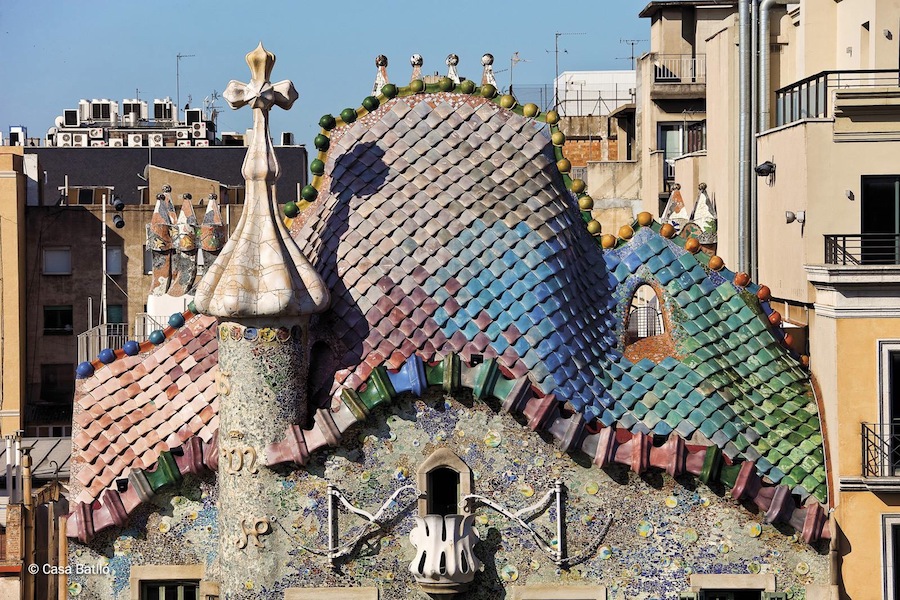
Facade
The facade has three distinct sections which are harmoniously integrated. The top displays a trim[disambiguation needed] with ceramic pieces that has attracted multiple interpretations. The central part, which reaches the last floor, is a multicolored section with protruding balconies. The lower ground floor with the main floor and two first-floor galleries are contained in a structure of Montjuic sandstone with undulating lines.
The top of the building is a crown, like a huge gable, which is at the same level as the roof and helps to conceal the room where there used to be water tanks. This room is currently empty. The roof’s arched profile recalls the spine of a dragon with ceramic tiles for scales, and a small triangular window towards the right of the structure simulates the eye. Legend has it that it was once possible to see the Sagrada Familia through this window, which was being built simultaneously. The view of the Sagrada Familia is now blocked from this vantage point by newer buildings.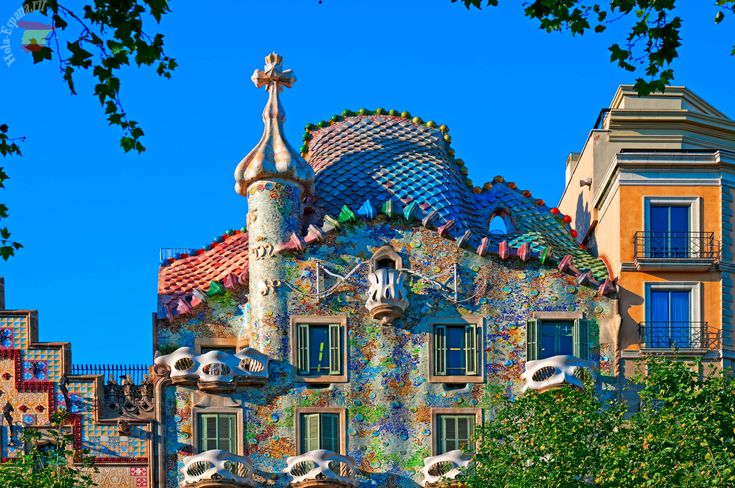
One of the highlights of the facade is a tower topped with a cross of four arms oriented to the cardinal directions. It is a bulbous, root-like structure that evokes plant life. There is a second bulb-shaped structure similarly reminiscent of a thalamus flower, which is represented by a cross with arms that are actually buds announcing the next flowering. The tower is decorated with monograms of Jesus (JHS), Maria (M with the ducal crown) and Joseph (JHP), made of ceramic pieces that stand out golden on the green background that covers the facade. These symbols show the deep religiosity of Gaudi, who was inspired by the contemporaneous construction of his basilica to choose the theme of the holy family. The bulb was broken when it was delivered, perhaps during transportation.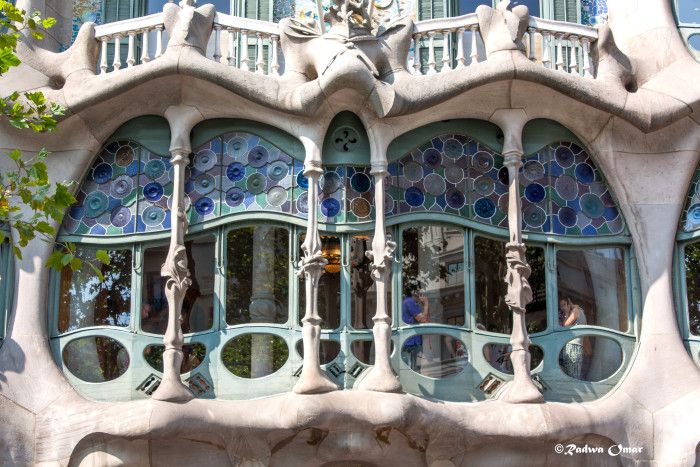
Finally, above the central part of the facade is a smaller balcony, also iron, with a different exterior aesthetic, closer to a local type of lily. Two iron arms were installed here to support a pulley to raise and lower furniture.
The facade of the main floor, made entirely in sandstone, and is supported by two columns.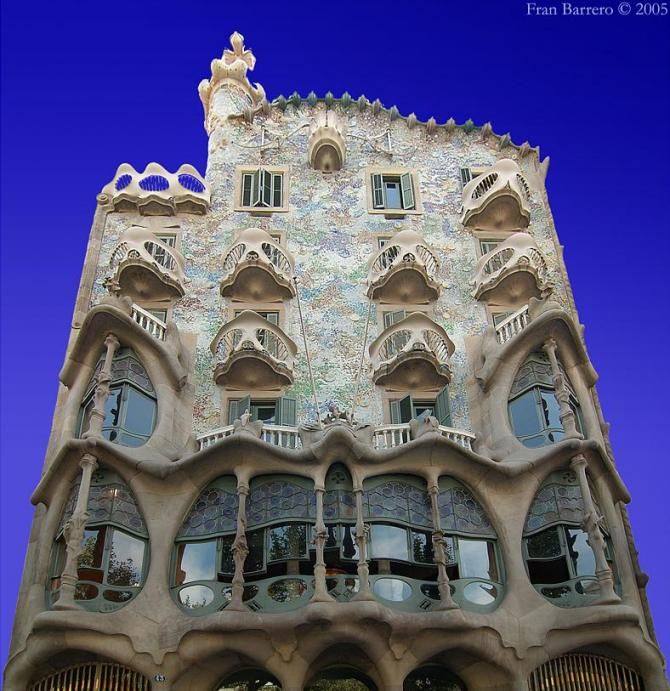
All2000 – present1980 – 19991940 – 19791920 – 1939Before 1920Go to article
All our texts and many of our images appear under the Creative Commons Attribution Share-Alike License (CC BY-SA). All our content is written and edited by our community.
Go to article
Casa Batllo in Barcelona (Casa Batllo)
Casa Batllo, along with the house of Mila, without a doubt, is the most famous, visited and, perhaps, unusual among the creations of the architect Antoni Gaudí.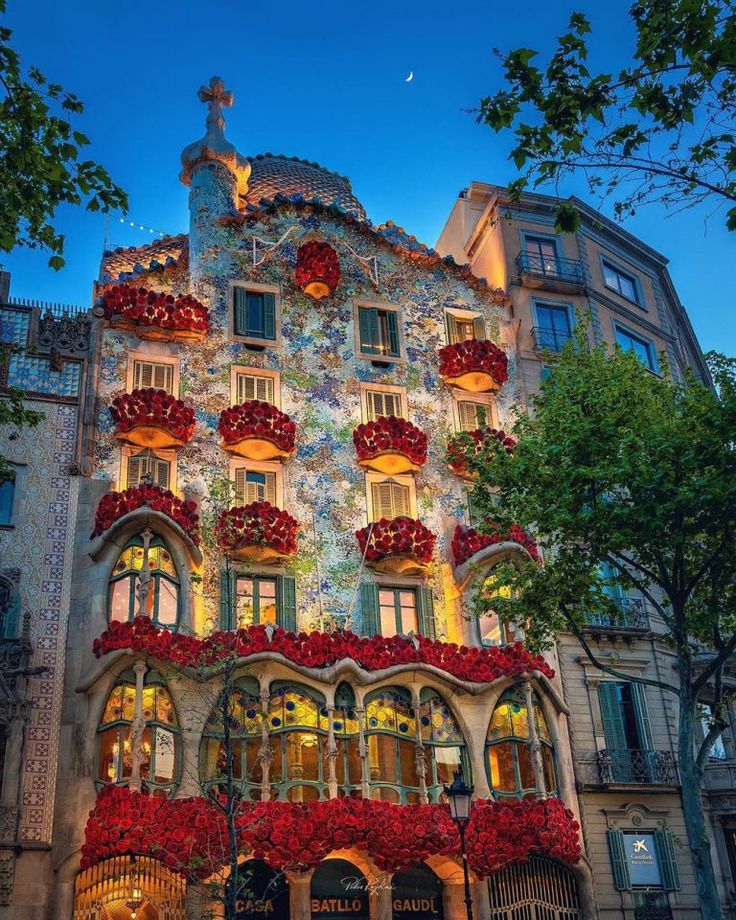
Both houses are included in the list of attractions in Barcelona and have long been an integral part of the tourist routes around the city.
Among visitors, Casa Batlló evokes rather mixed feelings. It impresses some, while others speak of the house very dryly. But one thing is for sure, Casa Batlló, like many other objects of Gaudi, leaves an indelible mark, positive or negative, it does not matter, but they will probably never stop talking about one of the most famous creations of Gaudi.
If you are going to visit Barcelona, or are already in the city, then you should definitely see Gaudí’s houses (Balló and Mila), at least in order to form your own opinion and fully get to know the charming and sophisticated capital of Catalonia.
Moreover, the house of Mila and the house of Batllo are located close to each other, and within walking distance from the historical center of Barcelona. More about Casa Mila in Barcelona…
Casa Batllo in Barcelona
Casa Batllo or Casa Batllo is Antoni Gaudí’s most daring project in Barcelona.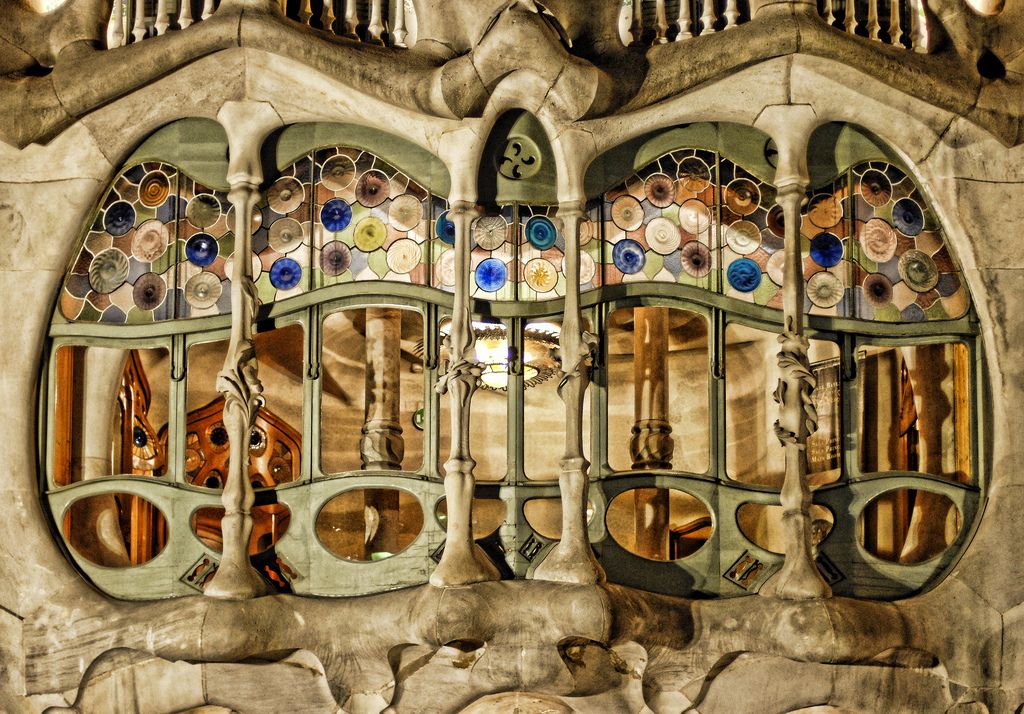
Casa Batllo is also a masterpiece of architecture and design, and one of Barcelona’s most iconic landmarks. It is also considered one of the best works of Antonio Gaudi, during the creation of which the architect revealed all his creative potential. And also the only work of the architect, made in the style of pure modernism, and which had the greatest interest in the international arena.
Casa Batlló is now a UNESCO World Heritage Site.
Since the architectural elements of the house resemble a skeleton, Casa Batlló is popularly known as the “House of Bones”.
Since 2002 Casa Batlló has been open for tours and other cultural events. Tours and activities are constantly updated both in terms of offer and content.
Entrance fee. Tickets can be purchased online – on the official website or at the Casa Batlló box office.
The house is open for visits daily from 09:00 to 21:00 (last entry at 20:00). The approximate duration of the visit is 1 hour.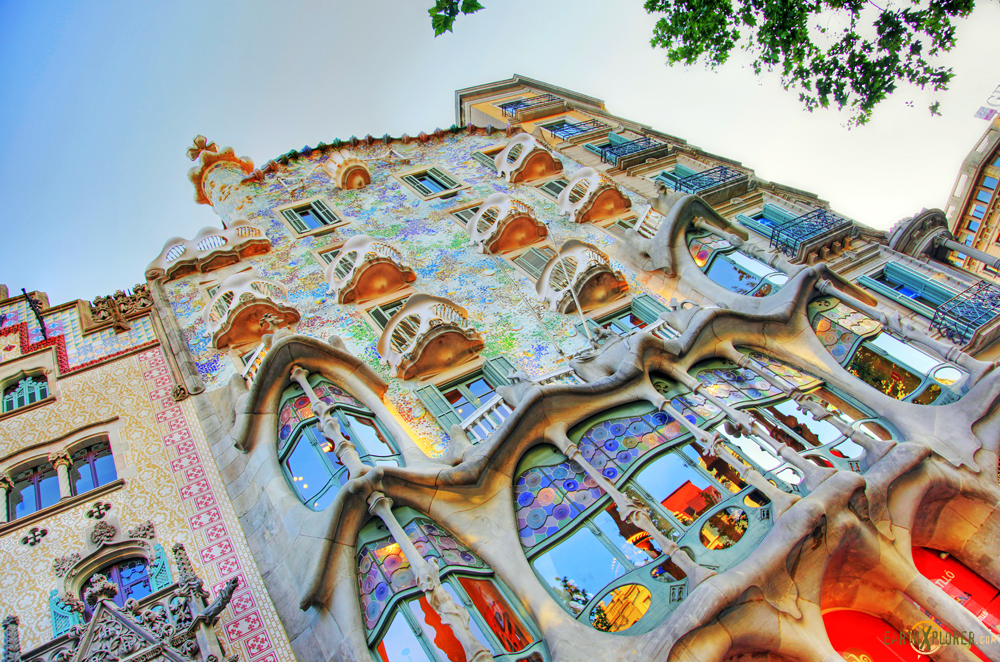
The cost of a regular ticket to visit Casa Batlló online is 35 Euro, at the box office – 39 Euro.
In addition, you can purchase a ticket with a fast pass, which will allow you to skip the general entrance queue or buy. There is a ticket for a theatrical visit.
Magical nights tour – night tour and live music in the open air on the terrace of Casa Batlló. This tour starts at 20:00 and includes an hour-long concert starting at 21:00 + two glasses of wine. Excursion cost 39Euro.
Tickets for the theatrical visit, magical nights, and house visits with an open date can only be purchased online.
History of Casa Batlló in Barcelona
The history of the construction of Casa Batlló dates back to 1877, when the house was built as a residential building.
In 1860, after the approval of the urban plan of Barcelona, Paseo de Gracia, where the Batllo house is located, became the main thoroughfare of the city. At that time, the most noble and wealthy families of Barcelona began to build their mansions along the avenue.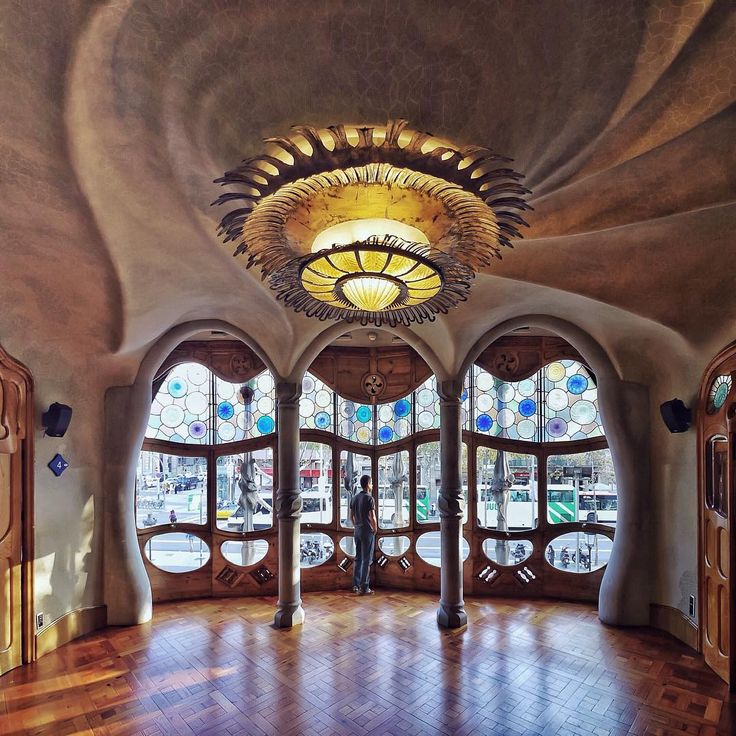
Initially, in 1877, Casa Batlló was designed and built by Gaudí’s teacher, Emilio Sala Cortés. In 1903, the building was acquired by the textile magnate Josep Batllo y Casanovas, after whom it received its now famous name.
Josep Batlló later commissioned Antonio Gaudí to redesign the building, for which he gave the architect complete creative freedom. Initially, it was planned to demolish the building and build a new project in its place. However, thanks to his courage, Gaudi refused to demolish the house and between 1904 and 1906 he made a complete reconstruction. Gaudi completely changed the facade of the building, redesigned the interior, expanded the patio and made the interior of the house a real work of art.
Casa Batlló ceased to belong to the Batlló family in the 50s. After several owners, both companies and private individuals, since the 1990s Casa Batlló has become the property of the Bernat family, who have completely restored the building.
In 1995, the Bernat family opened the doors of the house to the general public and introduced this architectural gem to the world, offering its truly unique venues for events and social gatherings.
Near Casa Batlló
At about the same time that Antoni Gaudí’s Casa Batllo was refurbished, other houses near the house were reconstructed under the direction of other eminent architects.
At that time, the reconstruction of houses began to have a personal connotation for the architects, as the architects competed with each other for architectural awards from the Barcelona City Hall. For this reason, this quarter became known as “la Manzana de la Discordia”, which means “Quarter of Discord” or “Apple of Discord”.
All the houses of the quarter were built in Art Nouveau style and now, together with Casa Batlló, form a unique architectural ensemble, which includes:
– Casa Amalie (the work of the architect Josep Puig i Cadafalch).
– House of Lleo y Morera (architect Lluis Domenech y Montaner).
– Casa Mulleras (architect Enrique Sagnier).
– Houses of Josephine Bonet (architect Marcel-ila-Coquilat).
Directly to Casa Batllo, on its left side, adjoins another well-known house – Casa Amalie.
House of Amalle
House of Amalle or House of Amatller (Casa Amatller), together with the House of Batlló, is an amazingly beautiful and memorable ensemble, where, on the one hand, the play of architectural elements and colors is subtly combined, forming a single picture, and on the other – houses have a sharp contrast with catchy differences.
Amalie’s house was originally built in 1875. On March 12, 1998, the industrialist and chocolate maker Antonio Amalle purchased the building, after which he ordered the reconstruction of the house from the famous Catalan master Josep Puig i Cadafalca. As a result of the work carried out, during which redevelopment was carried out and the decoration of the building was completed, the house received a second birth and sparkled with new colors.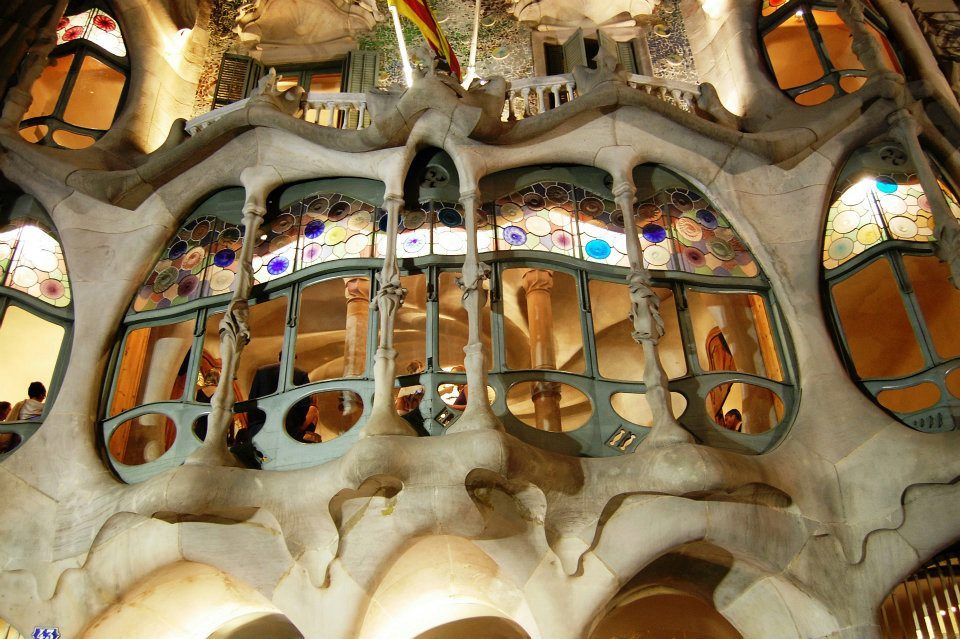
After restoration, in 2015 the Amallet house was opened as a museum, retaining some of the furniture and decorations from the 1900s.
Amalie’s house currently houses a chocolate shop and offers tours. The duration of the tour is 1 hour, includes a tour + a cup of hot chocolate. The price of an adult ticket is 24 Euro. Tickets can be purchased at the box office or on the official website.
House Lleo Morera
House Lleo Morera (Casa Lleo Morera) is another magnificent house located next to Casa Batllo in the “Quarter of Disagreement”.
The architect Lluís Domènech i Montaner was commissioned by Francesca Morera and Ortiz to work on the house of Lleo Morera in 1902. At that time, Paseo de Gracia 35 had an old building called Casa Rocamora, built in 1864. The architect Lewis Domènech y Montaner designed a complete project for the renovation of an existing home using a variety of materials. The reconstruction lasted until 1906, after which the building became a truly modernist work of art.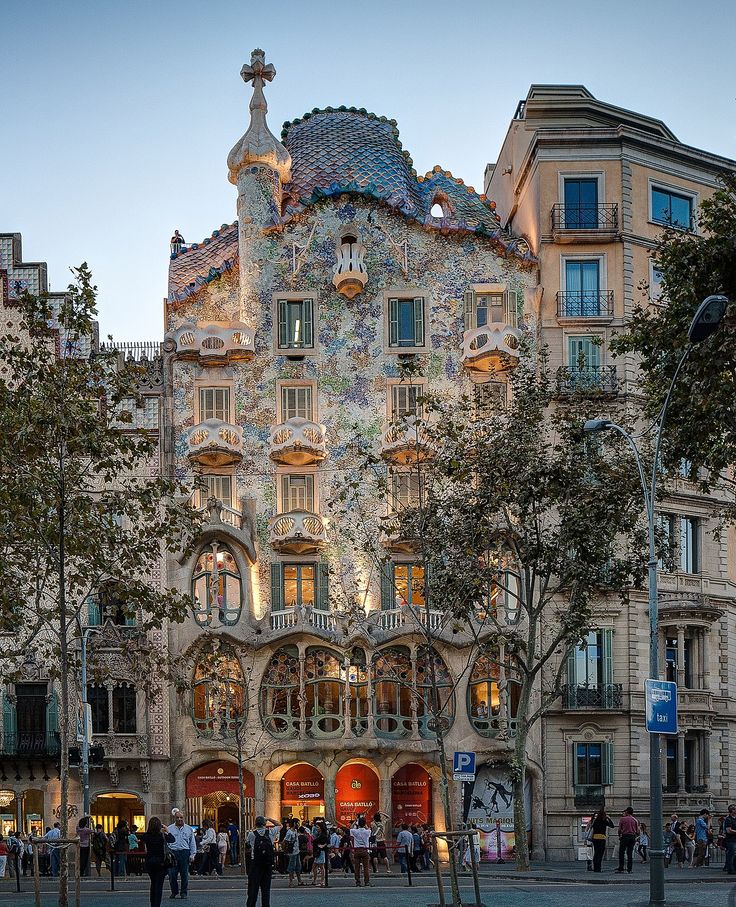
In the interior of Leo Morera’s house you can see an explosion of modernism, which is one of the best preserved in the city: stained glass windows, mosaics, ceramics, sculptures, wood, marble … everything has found its embodiment in the interior of this unusual house to this day.
Location and address of Casa Batlló in Barcelona
Casa Batlló is located 700 meters from Plaza Catalunya, at Passeig de Gràcia, 43, 08007 Barcelona, Spain. From Plaza Catalunya you should go up (from the sea), along Passeig de Gracia (Passeig de Gràcia).
How to get there . Metro : Passeig de Gràcia, L2, L3 and L4.
Trains : RENFE stop Passeig de Gràcia. FGC, stop Provença.
Buses : h20, V15, 7, 22 and 24.
Casa Batlló: history, construction, description, photos 7
Start of construction: 1904
Construction completed: 1906
Architect: Antoni Gaudí
Coordinates: 41°23’30.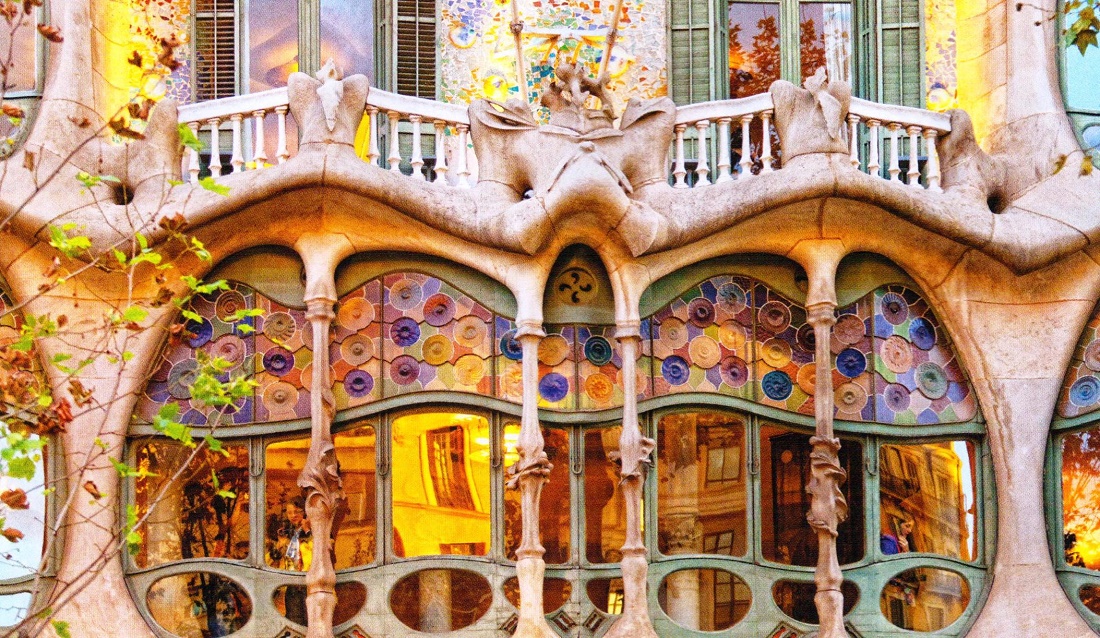
Content:
Short description
Construction and reconstruction
Casa Batlló – a view from the outside
Casa Batlló on the map
Quick description
In Barcelona, which can be safely called a city of contrasts, on Passeig de Gracia is perhaps the most amazing residential building in the whole world.
View of Casa Batllo from Passeig de Gracia
It is simply impossible not to notice it from the window of a car or a sightseeing bus: it instantly captures the eyes of the guests of the capital of Catalonia and causes them a state similar to something with dumb shock . This house is one of the greatest creations of the brilliant Catalan architect Antonio Gaudí.
Casa Batlló, Casa Batlló, House of Bones are all names for an architectural masterpiece on Passeig de Gràcia at number 43 . Near this landmark of Barcelona, you can always meet huge and noisy crowds of tourists trying to capture the house from all angles, often taking ridiculous and funny poses for this.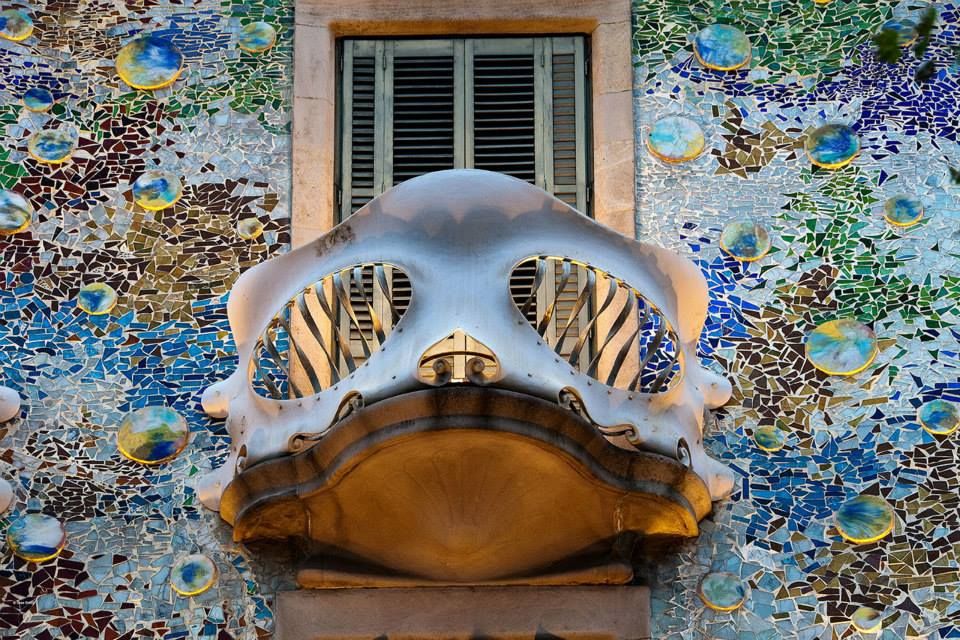
View of the facade of the house
Casa Batlló – construction and reconstruction
There is practically nothing to talk about the construction of the house itself, owned by Josep Batllo y Casanovas. In two years (from 1875 to 1877), the workers, in record time, built the most ordinary and unremarkable tenement house.
In order to leave a memory of himself, in 1904 the industrialist made an order for the reconstruction of the house to the architect Antonio Gaudí, who had already become famous for his work. By the way, at the time of receiving the order, Gaudi was still working on Park Güell. Casanovas was so dissatisfied with the appearance of his apartment building and so inspired by the work of Antoni Gaudi that he decided to completely demolish the building. However, the architect, having calculated and thought through everything to the smallest detail, stops the textile worker from such a rash step and begins work on the reconstruction of the finished building.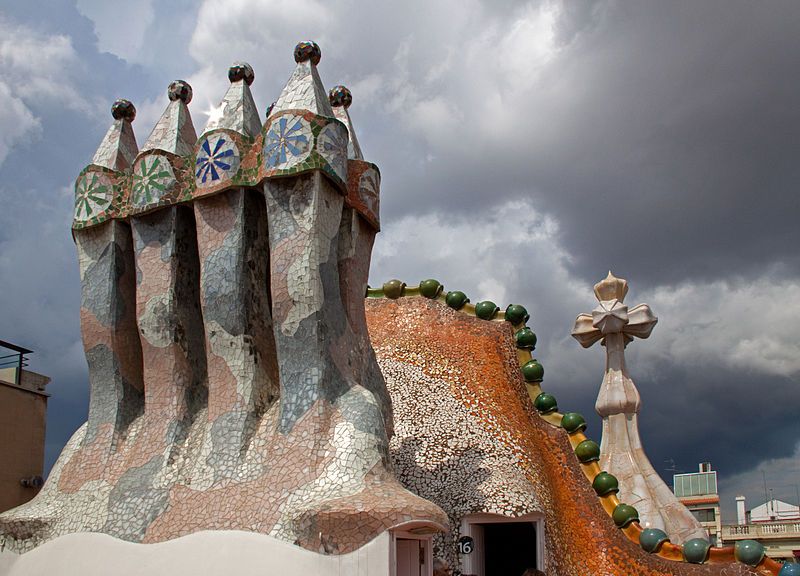
Fragment of the facade of the building
In order to create his next masterpiece, Antonio Gaudi completely changes the facades of the house, but leaves the original structure of the building. According to experts, Casa Batlló is a new round in the work of the architect and another proof that in his works, in addition to design, great attention is paid to both rationalism and calculations . In just two years, Antonio Gaudí completely rebuilds two facades of Josep Batlló y Casanovas’ apartment building. One of them can be seen by everyone who drives or walks along the Passeig de Gràcia, and the second facade is visible from the courtyard of the house, which has also been completely renovated to fully match the design of the House of Batllo or the House of Bones – as you like.… To create an amazing interior courtyard of the building, Gaudí was able to connect two so-called light shafts. And in this work, the rationalism of the brilliant architect is visible: the combination of two light shafts made it possible not only to create an amazing, beautiful courtyard, which, unfortunately, is so difficult to describe in words, but also to significantly improve the ventilation in the building, as well as to achieve good lighting of the premises due to natural light.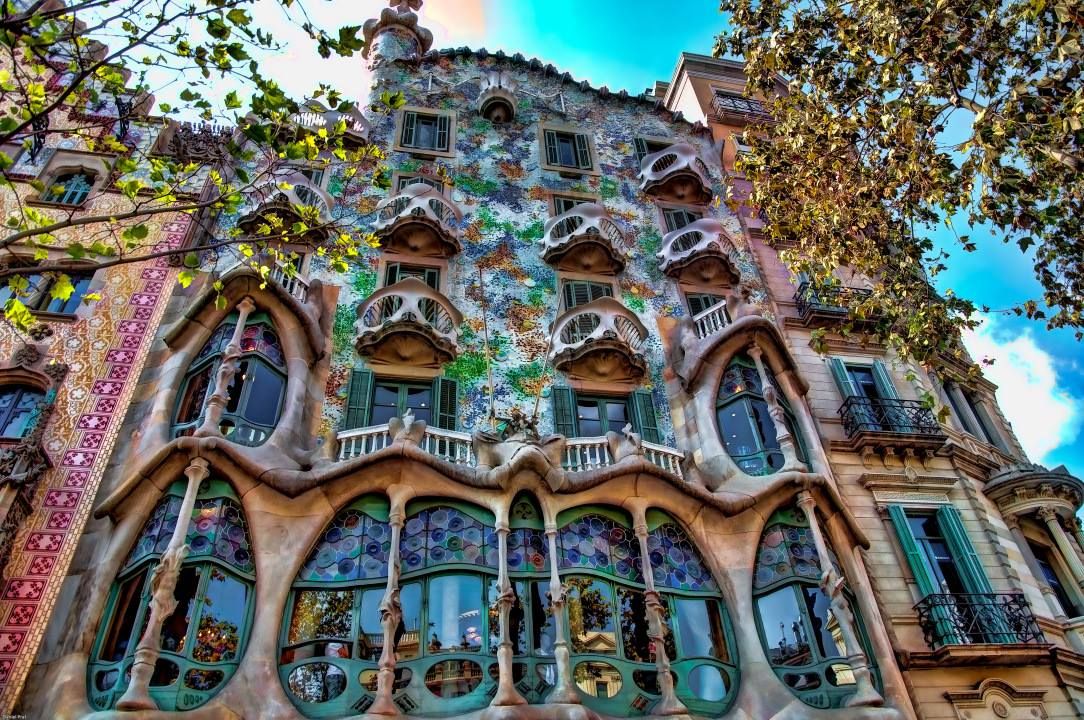
View of the upper floors of the building and the turret with a cross
“The courtyard of Casa Batlló, built by Gaudi, perfectly reveals the secrets of success to modern architects. Many are trying in our time to build amazing and bizarre buildings, while forgetting about their practicality. His view of the world around him, the absence of patterns, and most importantly, with all this, rationalism, this is what distinguishes him from any other, albeit a talented architect, Antonio Gaudi! architects of the 21st century.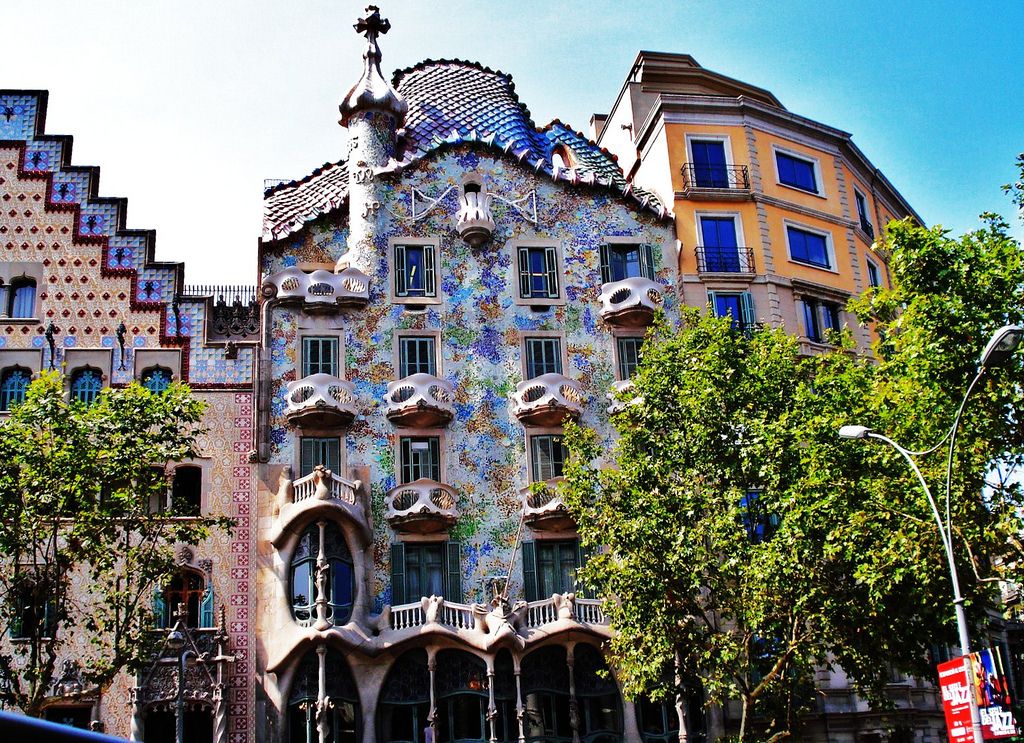
In addition to the work on the facades, Antoni Gaudí decided to almost completely rebuild the first floor and mezzanine. As you know, the architect, who was the best friend of Usebi Güell, was talented in everything: he not only rebuilds the premises, he creates for them unique and stylish furniture that you cannot currently find in the house. For security reasons, it is kept in the Antonio Gaudi House Museum, located in Park Güell, which previously any guest of Barcelona could enter absolutely free of charge. In addition, the architect, who was allocated a decent budget for those times, completes the construction of an attic, a basement and a beautiful stepped roof terrace in the house, on which every traveler who comes to the Catalan city rises to see Gaudí’s masterpieces with his own eyes.
The back side of Casa Batlló
All unique elements of Casa Batlló, designed by the architect, were handed over to be created by the best craftsmen of that time: Josep Pelegri worked on the stained-glass windows, forged details were made by Badia blacksmiths, by the way, to these two talented brothers who managed to gain power over the metal, Gaudí addressed more than once.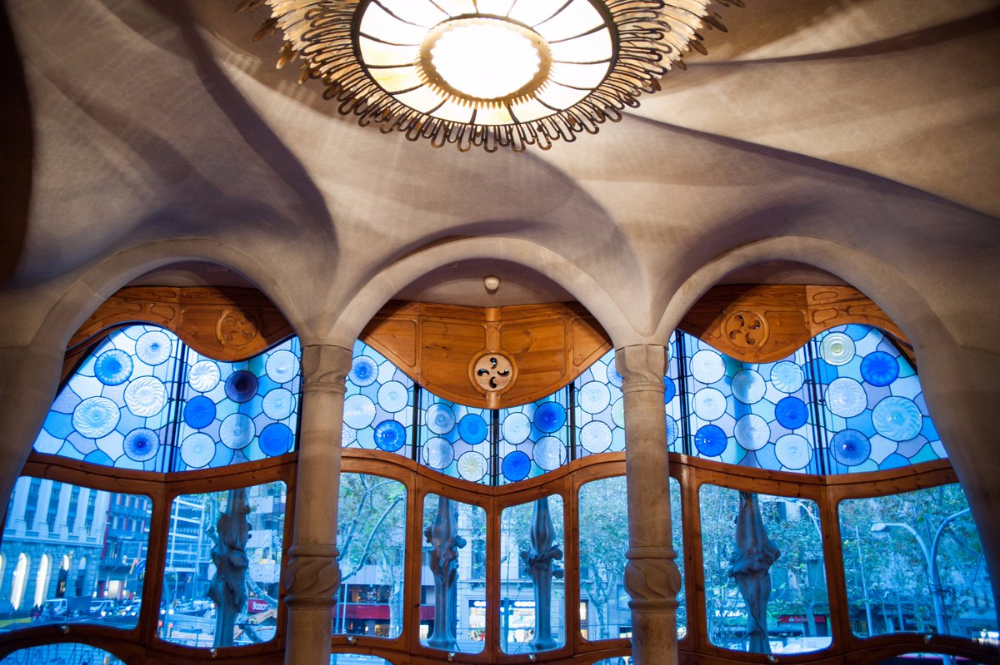
Casa Batlló – a view from the side
The first thing that attracts attention is the vague, “viscous lines” of all decorative elements and the almost complete lack of symmetry in the facade of the building overlooking Passeig de Gracia. The first impression is that the house is built from the bones and skulls of giant people. It is thanks to this similarity that the inhabitants of Barcelona, almost immediately after Gaudi handed over the building to the customer, called it the “House of Bones”.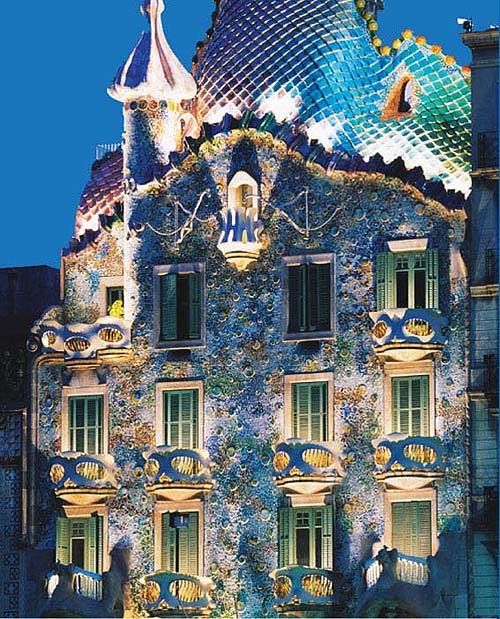
On the roof
Gaudí’s talent is exceedingly difficult, or rather impossible. The thing is that in order for unique buildings to be born, not only the talent of an architect is necessary, but also his own vision of the world around him. Even if someone built something similar at the moment, they would still be accused of plagiarism or not taken seriously. Brilliant architects, however, as well as artists, sculptors and poets are not compared, their talent is simply admired.
The windows on the first floor look like the windows of some fabulous house: they are all irregular in shape and seem soft, “blurring”, “plasticine”. Naturally, this impression is deceptive: all the elements are made of durable stones, which the carver worked on. The stones used in the decoration of the façade come from the Montjuic hill.
After the tourist comes to his senses from the splendor of the first floor of the building, looking up, it begins to seem to him that Casa Batlló, despite its small size, “goes into the sky.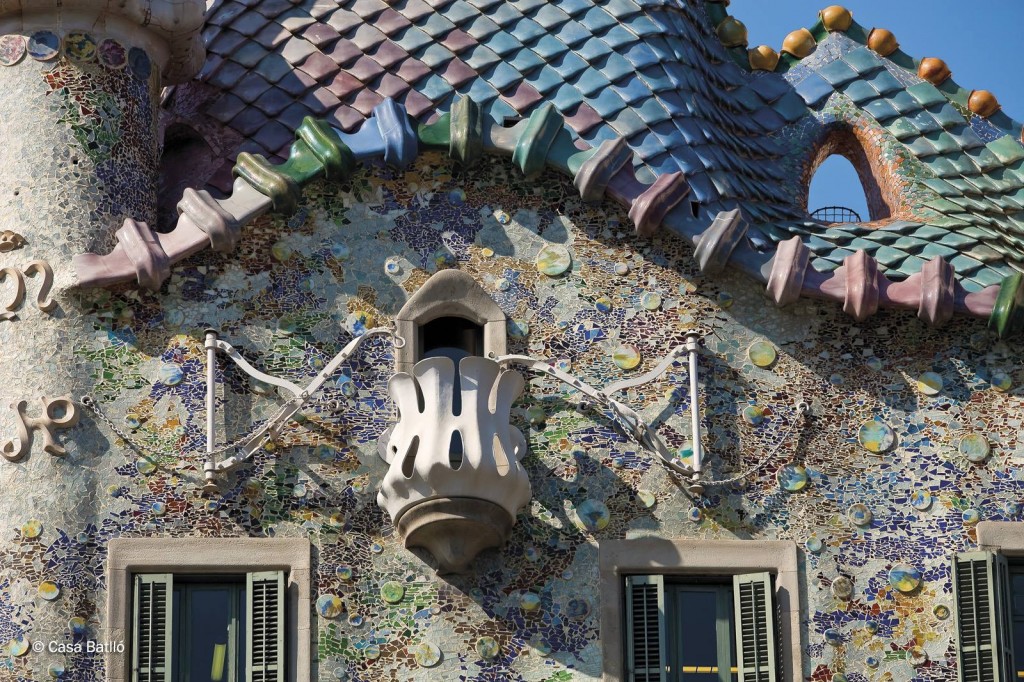
If it is pale golden at the bottom, then it becomes orange towards the top and gradually turns into turquoise. The roof of the Casa Batllo, at first glance, seems to be taken from a completely different structure: it seems that the spine of some prehistoric monster sticks out of it, and it is studded with silvery scales. The amazing building is crowned with a turret with a cross. It is not located in the center, but shifted to the left side (another manifestation of asymmetry in Gaudí’s masterpiece).
Any guide who conducts tours of Barcelona will immediately tell you that in their work on Dom Batllo or, as Russian tourists call it Dom Batllo , Antoni Gaudí was, as always, symbolic. The roof of the building is a cruel dragon, the building itself, resembling a pile of bones and a skull – its victims, and that same small turret is the hilt of the sword of St.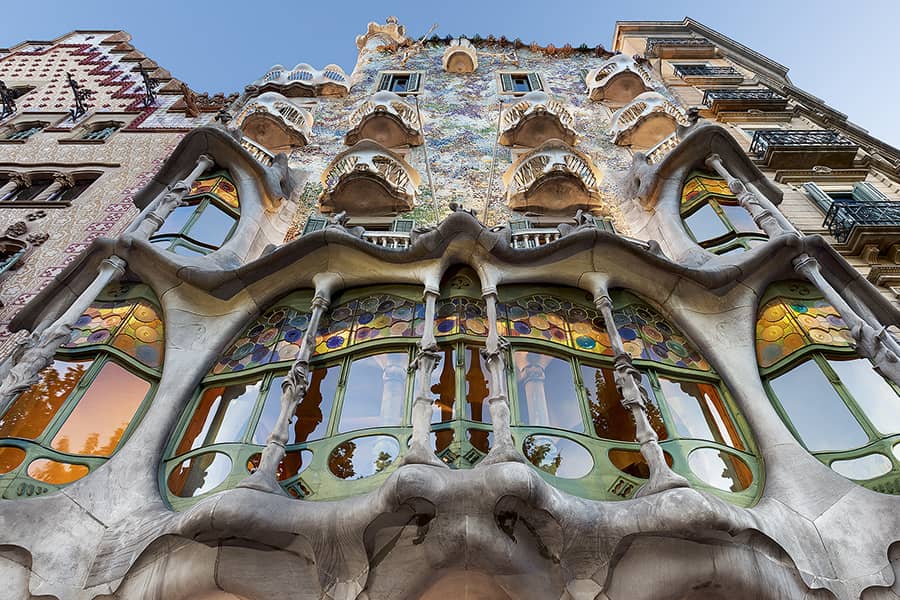
Fragment of the roof of the building
The facades of Casa Batlló, its roof and courtyard are far from all that Gaudí created. The architect and, as they would call him now, the designer, worked on the decorations of the interior. The fireplace room, stairs and other rooms are made in a style that is quite difficult to attribute to any of the existing ones. It is officially considered that the masterpiece of Antonio Gaudi called Casa Batlló is made in the Art Nouveau style.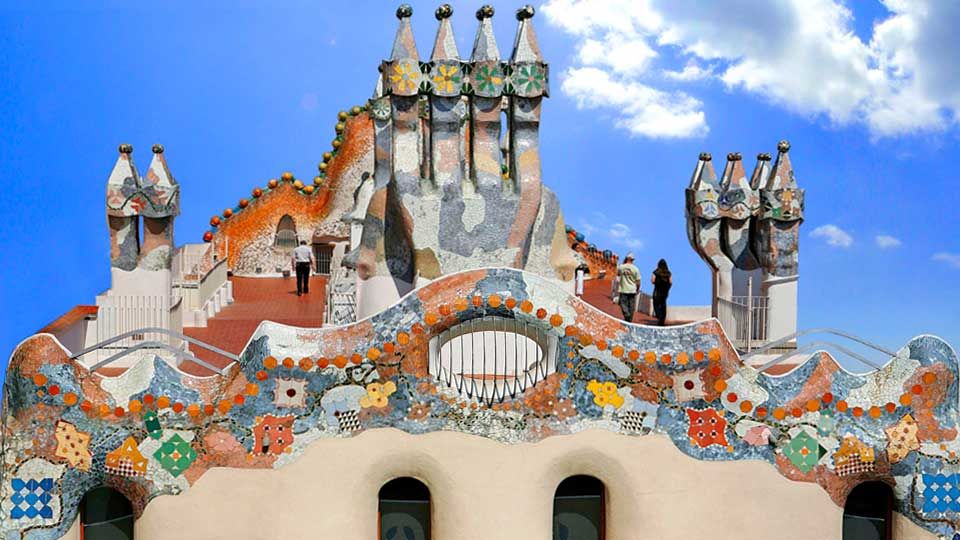
A tourist who travels to Barcelona to see its many sights will naturally not miss the opportunity to come to Casa Batlló. It is described in all tourist brochures for the Catalan capital, because this is one of its main attractions of the “Quarter of Disagreement”, which all the indigenous inhabitants of the city are proud of without exception. By the way, this area is called the “Quarter of Disagreement” due to the fact that there are practically no buildings of the same type in it, and each house is built in its own unique style. The industrialist Batllo’s house is one of such buildings.
Ventilation pipes
Quite often you can hear from the Catalans that Josep Batllo y Casanovas was extremely lucky. He was lucky not because he managed to make good money in the production of textiles, but because he entrusted the reconstruction of his house to Antonio Gaudi.

